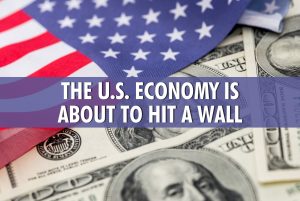The U.S. ECOMOMY IS ABOUT TO HIT A WALL

The U.S. economy is expected to post another roaring growth spurt in the second quarter, before a slow and steady dose of reality starts to sink in.
Most economists believe that the U.S. economy is currently very close to, if not actually above, its maximum sustainable level of employment and capacity utilization. If they are right, from this point onward growth will have to come from increases either in productivity—that is, in the volume of output per worker—or in the size of the potential workforce; and official statistics show both productivity and the workforce growing sluggishly. So standard economic analysis suggests that the United States cannot look forward to growth at a rate of much more over the next few years. Furthermore, such analysis indicates that if the Federal Reserve Bank tries to force faster growth by keeping interest rates low, the main result will merely be a return to the bad old days of serious inflation.
However, many influential people—business leaders, journalists, and even a few reputable economists—do not accept that verdict. They believe that the old speed limits on growth have been repealed, perhaps even that the whole idea of speed limits is obsolete. The conceptual basis for their optimism is sometimes referred to as the new economy view, . Whatever one calls it, this new view of the economy has spread with a rapidity rare in the annals of economic thought.
The changes everyone can see in the U.S. economy—the rise of digital technology and the growing volume of international trade and investment—have qualitatively altered the rules of the game. Rapid technological change means that the economy can grow much faster than it used to; global competition means that an overheating economy will not produce high inflation. That is obviously an attractive view to anyone who would like to see more rapid growth than the disappointing 2-point-something percent offered by conventional economists; it is also a view that many business people insist corresponds to what they see happening in their own industries. So, we should not be surprised at the popularity of this view in the business community.
The U.S. economy when it slips into a recession. And the ability of a Paul Volcker or an Alan Greenspan to engineer a recovery from such a recession rests on his control over the money supply, second economists don’t argue against overambitious growth targets because they believe that all growth causes inflation. That is a misleading caricature of what economists are saying, and like all caricatures it is easy to ridicule.
Source: Investing.com
